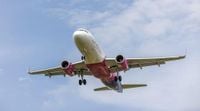Travellers from the UK heading to Europe this autumn and winter are facing a new reality at the border: the roll-out of the European Union’s Entry/Exit System (EES). The digital system, which officially launched on October 12, 2025, is being gradually introduced at airports across the continent, including at popular destinations such as Spain and Greece, according to Manchester Evening News. Its goal? To streamline border crossings by replacing manual passport stamps with biometric data collection, such as facial photographs and fingerprints, for most non-EU citizens.
The change is significant, impacting millions of people each year. The Schengen area, which encompasses 29 participating countries, sees over 500 million entries and exits annually and operates 1,800 border crossings, as reported by the Evening Standard. Under the new system, third-country nationals—including British travellers post-Brexit—are now required to register their biometric data before entering the Schengen zone. This information is stored in a central EU database, a move designed to make travel more efficient in the long run.
But as with any sweeping change, teething problems have emerged. Early reports from airports paint a picture of long queues, confusion, and delays. Travellers from Turkey, Egypt, and the United Arab Emirates, for example, have experienced wait-times of up to 90 minutes, with some airports resorting to manual processing as new machines remain switched off. Hamilton Nash, a Londoner caught up in the new procedures, described his experience: “Just fought through the queues. No machines operating. It’s an hour to 90-minute long queue.” Another traveller, Stuart Linden Rhodes, added, “All machines still switched off, heading to an hour now. Fingers and eyes being done at the passport control desk. Usual exit, glare at you and then your passport before stamping it.”
These stories are not isolated. The Evening Standard notes that the Czech Republic, Estonia, and Luxembourg have announced plans to fingerprint and photograph all third-country nationals, adding to the processing time and, inevitably, to the queues. The new system’s early days have seen bottlenecks and delays, with Julia Lo Bue-Said, chief executive of Advantage Travel Partnership, warning travellers to be prepared. Speaking to the BBC’s Today programme, she advised: “Make sure, where possible, you’re leaving yourself between three and four hours from the point of entry.” She elaborated, “You may be going for a concert, you may be going for a meeting, you may be going for a wedding, for a cruise. If you’re not leaving yourself enough time and you unfortunately arrive at an airport where there is a bottleneck, which in a lot of places there are already, this is going to add another layer of frustration and delay.”
Michael O’Leary, the outspoken CEO of Ryanair, didn’t mince words when asked about the new system’s prospects. “I’m pretty certain it’s going to go wrong,” he said, expressing skepticism about a smooth transition. O’Leary added, “We’re moving into the winter period, so there’s a lot less pressure on, but I think it will be bumpy and lumpy through the winter.” His concerns echo those of many in the travel industry, who fear that the combination of new technology, unfamiliar procedures, and high passenger volumes could create a perfect storm of disruption—especially as the scheme requires all Schengen member states to become EES-compliant within 180 days of launch.
For British travellers, the new rules mean that, in most cases, they’ll need to have their faces photographed and their fingerprints scanned at the border. Once fully operational, the system will eliminate the need for physical passport stamps—a familiar ritual for generations of holidaymakers. In theory, this should speed up the process, but during the current transition period, many are being warned to expect the opposite. The Manchester Evening News cautions that some holidaymakers could face airport delays of up to four hours, especially during peak travel times or at airports still adjusting to the new regime.
Not everyone is affected equally, however. The EU has outlined several exemptions for travellers who do not need to register their biometric data under the EES. These include non-EU nationals holding residence cards or permits related to EU nationals, heads of state, diplomats on short stays (under certain conditions), nationals of Andorra, Monaco, and San Marino who hold Vatican passports, and those traveling as part of intra-corporate transfers for research, study, or educational projects. Nationals of Cyprus and Ireland—countries not participating in the EES—are also exempt. The full list of exemptions is available on the EU’s official website, but for most British tourists and business travellers, the new procedures will apply.
So, what’s the rationale behind the EES? The EU’s stated aim is to make border crossings “quicker and more efficient,” reducing the administrative burden on border officials and improving security by keeping a digital record of entries and exits. By storing biometric data, authorities hope to clamp down on illegal overstays and better manage migration flows. In the long term, the system could pave the way for even more seamless travel within Europe, with less paperwork and fewer manual checks.
In the short term, though, patience will be a virtue for anyone flying into a Schengen country. The transition period is likely to be marked by a mix of confusion and adaptation, as both travellers and border staff get to grips with the new technology. The experience will vary from airport to airport, and even from day to day, as the system is fine-tuned and staff become more familiar with the procedures. Some airports are already running manual checks due to technical hiccups or incomplete installations, while others are operating the new system at full capacity.
The travel industry, meanwhile, is watching closely. Airlines, tour operators, and travel agents are all bracing for a winter of potential disruption. Many are urging passengers to check with their airlines and allow extra time for border formalities, especially if they have tight connections or important events to attend upon arrival. As Julia Lo Bue-Said summed up, “If you’re not leaving yourself enough time and you unfortunately arrive at an airport where there is a bottleneck, which in a lot of places there are already, this is going to add another layer of frustration and delay.”
The coming months will be a critical test for the EES. If the system delivers on its promise, future trips to Europe could become smoother and more secure. For now, though, British travellers are being advised to pack their patience—and perhaps a good book—for their next journey through Europe’s digital frontier.




